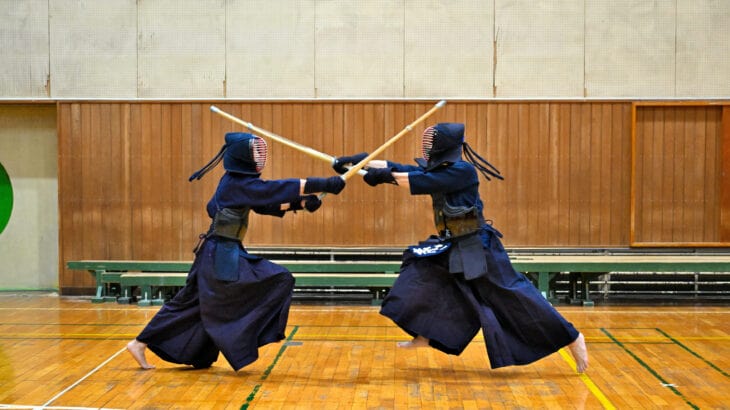
When learning Kendo, the key to improving your technique is practicing “Suburi.”
Suburi is the basis of Kendo, and is one of the important practice methods that is essential for improving your skills.
However, there are many different types and methods than just swinging a sword, each with their own characteristics and purpose .
In this article, we will thoroughly explain the types of practice swings in Kendo and their effects, from basic to advanced.
Whether you’re a beginner or an experienced Kendo player, find the type of practice move that suits your level and use it to improve your technique.
Now, let’s take a deep dive into the world of kendo practice.
目次
- 1 Basics of Kendo practice swing: Why is practice practice important?
- 2 Types and points of practice swings for beginners
- 3 Practical swing practice methods for advanced players
- 4 Common mistakes in practice swings and how to correct them
- 5 Ensuring equipment and safety during practice swings
- 6 What are the effects of Kendo practice?
- 7 summary
Basics of Kendo practice swing: Why is practice practice important?
In Kendo, suburi is more than just swinging the sword.
Through practice, kendo practitioners learn how to handle the sword, how to use their body, and how to concentrate mentally.
Here, we will take a deep dive into the purpose and importance of suburi, and its role in improving the basic techniques of kendo.
Purpose of practicing
The most basic purpose of Suburi is to instill Kendo techniques into your body. By repeatedly practicing the correct posture and swinging the sword, you will develop a technical foundation.
Suburi also aims to unify the three elements of Kendo: spirit, sword, and body.
This allows kendo practitioners to put their whole body and soul into each swing.
The importance of practice swings
- Technical Mastery : Accurate sword trajectory, proper foot movement, and power transfer. All of these are essential to success in matches and kata performances.
- Improve your physical strength and endurance : Practice swings are a full-body exercise, and continuous practice will improve your physical strength and endurance. This allows you to build a body that is less tiring even during long training sessions and competitions.
- Strengthening mental concentration : Practice swings tend to seem like a monotonous exercise, but through repetition you can improve your mental concentration. By concentrating on each swing, you can train your mind.
- Deepen your understanding of the basics : You can deepen your understanding of the basic techniques and movements of Kendo. Through practice swings, you will learn how Kendo forms and movements work and why they move the way they do.
Improving technique through practice swings
In Kendo, it is often said that the secret to improvement lies in the basics. Practice swings are one of the most effective ways to hone the basics.
By performing practice swings in the correct form, not only the way you swing the sword, but also the movement of your feet and body when striking will naturally become correct.
Learning these basic movements will directly improve your overall Kendo technique.
Through practicing practice, kendo practitioners can solidify their technique and aim for even greater heights.
Again, the value of practice swings in Kendo goes beyond just physical movement. This is an essential step to mastering Kendo.

Types and points of practice swings for beginners
For beginners who have just started Kendo, suburi is an important exercise that lays the foundation of Kendo techniques.
Here, we will explain the types of practice swings that beginners should learn first, and the points to be aware of with each practice swing.
Basic swing
1. Swing straight
- Type and purpose : A basic practice swing in which the sword is swung straight down from above the head. Cultivate the accuracy of the sword’s trajectory and posture.
- Tip : Swing with your shoulders relaxed and relaxed. Make sure that the tip of the sword goes down in a straight line, and the sword should be in front of you in the final position.
2. Small gesture
- Type and purpose : A practice swing that imitates the action of hitting the kote (wrist). Learn how to hit your wrist and the feeling of swinging.
- Point : When making a kote, swing down lightly. Be aware of the position of the tip of the sword after hitting it, and complete it with the correct form.
3. Face turn
- Type and purpose : A practice swing that involves hitting the face. Develop the correct method of men-uchi and the sense of furi-buki.
- Tip : When swinging up, extend your elbows firmly, and when swinging down, make sure to hit the center of the plane. By matching the movement of the feet and swinging down while stepping with the front foot, it creates a sense of unity.
Common points during practice swings
- Maintain correct posture : Maintaining correct posture is important when performing any practice swing. Keep your back straight, your face facing forward, and relaxed.
- Be aware of your breathing : By breathing in time with your practice swing movements, your movements will become smoother. In particular, it is a good idea to exhale while swinging down.
- Practice repeatedly : The effects of practice swings will be seen through repeated practice. It may be difficult at first, but repeating practice in the correct form is the shortcut to improvement.
For beginners in Kendo, it is important to start with these basic movements and learn the correct form.
Through repeated practice, your Kendo techniques will gradually improve and you will step up to more advanced techniques.

Practical swing practice methods for advanced players
In order to step up from intermediate to advanced level in Kendo, more advanced practice is required.
Here, we will provide practice techniques that advanced players should aim for, as well as specific advice to improve their technique.
Continuous practice swing
1. Multi-step practice
- Practice method and purpose : Practice swings that involve hitting multiple striking targets such as men, kote, and torso in a series of movements. Learn the continuity of attacks and the flow of connecting multiple techniques.
- Tip : It is important that each strike appears to be independent and that there is a flow from the previous strike to the next. Rather than resetting after each strike, develop a sense of developing techniques in a series of sequences.
Irregular practice swing
2. Practice swings while moving
- Practice method and purpose : Practice swinging while moving forward, backward, and sideways. Maintain your balance while moving and improve your ability to perform accurate strikes.
- Advice : When moving, be aware that the movement of your feet and the movement of your sword are in sync. In particular, when changing direction of movement, pay attention to how you place your feet and the direction of your body, and practice so that you can always practice swings in a stable position.
precision practice swing
3. Dot-striking practice
- Practice method and purpose : A practice swing that hits a target within a very limited range. Develop the ability to strike with high precision and reliably hit the point you are aiming for.
- Advice : Make sure that the tip of the sword reaches the target point accurately. At first, focus on accuracy by moving slowly, and gradually increase the speed, but care must be taken to ensure that accuracy does not decrease as the speed increases.
Common advice for practice swings
- Perform self-analysis : When performing practice swings, it is a good idea to record a video of your movements and analyze them later. Especially for advanced players, it is important to improve subtle techniques.
- Concentration of consciousness : It is important to concentrate all your attention on each practice swing, and to do it with meaning and purpose, rather than just performing the form.
- Breathing and Rhythm : By learning proper breathing techniques and being aware of the rhythm of your practice swings, you will be able to practice more effectively.
Even if you become an advanced player, it is important to return to the basics of practicing practice and aim to further improve your technique.
By incorporating these practice methods into your daily practice, you will be able to increase the precision and depth of your Kendo techniques.

Common mistakes in practice swings and how to correct them
Kendo practice is essential for acquiring and improving basic techniques.
However, if you do not do it correctly, you will learn inefficient movements and this will not lead to technical improvement.
Here we will explain common mistakes made when practicing practice swings and how to correct them.
Mistake 1: Using brute force
- Details of the error : Swinging the sword down with too much force. This can cause the swing to become too large or cause unnatural movements.
- How to fix it : When swinging the sword, it is important to relax your shoulders. Swinging down is performed not only by the strength of the arms, but also by the rotation of the hips. Also, while feeling the weight of the sword, learn how to swing it down naturally using gravity.
Mistake 2: Inaccurate trajectory
- Details of the error : The trajectory of the sword swing is not straight, but diagonal.
- How to fix : When swinging the sword, make sure that the tip of the sword points straight down. For beginners, it can be helpful to use a mirror or videography to check the trajectory of your sword. It is also a good idea to set a target point and practice hitting that point with the tip of your sword.
Mistake 3: Improper foot movements
- Details of the error : The movement of the legs during practice swings is unstable, or the movements of the body and legs are not synchronized.
- How to correct : It is important to perform practice swings while being aware of the movement of your feet. While maintaining correct posture, plant your feet firmly on the ground and match the movements of your body with the movements of your feet. Always try to maintain a stable posture, whether you are stepping forward or stepping back.
Mistake 4: Irregular breathing
- Details of the error : Breathing is shallow or irregular when performing practice swings.
- How to correct : It is important to synchronize your breathing with your practice swing movements. By inhaling when swinging up and exhaling when swinging down, you can create a rhythm and make the movements smoother. Try to breathe deeply and practice controlling your breathing through a series of movements.
By being aware of these common mistakes and how to correct them when practicing practice swings, you can efficiently improve your technique.
Practicing with correct form is the shortcut to improving in Kendo.

Ensuring equipment and safety during practice swings
When practicing Kendo, it is very important to use the correct equipment and ensure safety.
Here we will introduce recommended equipment for effective practice swings and precautions to keep you safe during practice.
Recommended equipment
1. Shinai
- Features : Main equipment used in actual Kendo matches and practices. The weight and balance are close to those in actual combat, making it ideal for practice swings.
- How to choose : It is important to choose the size that suits your height and hand size. Also, choose a Shinai that is easy to hold and has a weight that makes it easy to swing.
2. Wooden sword
- Features : Made of wood and slightly heavier than a bamboo sword. It is useful for strength training by shaking and for stabilizing your form.
- Precautions when using : Until you get used to the weight, be careful not to put too much strain on your muscles.
3. Subliminal training equipment (weighted shinai, etc.)
- Features : It is heavier than regular Shinai or Bokken, and is intended to improve muscle strength, swing speed, and form.
- Precautions when using : It is recommended that you start using it for a short time and gradually get used to it. To prevent injury, avoid overexercising.
Ensuring safety
1. Check the practice environment
- Tip : Make sure there is enough space where you practice swings. Make sure there are no people or objects around you and maintain a safe distance.
2. Preparation of the body
- Tip : Before you start practice swinging, it is important to warm up your body with a proper warm-up and stretching. Make sure to relax your muscles enough to prevent injury.
3. Inspecting the tools used
- Tip : Before practicing, check that the shinai or wooden sword you use has no cracks or damage. In particular, in the case of Shinai, cracks can cause injury, so regular inspection and replacement as necessary are essential.
4. Maintaining proper form
- Tip : It is important to always be aware of correct Kendo form to prevent injuries. You can continue practicing without straining by practicing with natural movements without straining too much.
By paying attention to how to choose these tools and ensuring their safety, you can practice swinging effectively and safely.
Daily practice is essential to improving your Kendo skills, but please always put safety first.

What are the effects of Kendo practice?
Practicing practice swings in Kendo not only improves technique, but also has a great impact on strengthening physical ability and training mentally.
Here, we will introduce the specific effects that practicing practice has on Kendo technique and emphasize the importance of continuous practice.
Technical effects
Accurate technique acquisition
- Effect : You can learn the basic techniques of Kendo, such as correct posture, swings, and foot movements. Through repeated practice, these movements will naturally become ingrained in your body and you will be able to perform accurate techniques automatically.
Understanding the correct use of power
- Effect : Learn how to use force effectively when swinging a sword, how to apply force when swinging, and when to swing. This allows for sharper and more accurate strikes during matches and practice.
Effect on physical ability
Improved muscle strength and endurance
- Effect : Practicing swings that use the whole body contributes to improving muscle strength. In particular, the muscles in your arms, hips, and legs will be strengthened, making your body less tiring even during long training sessions and competitions.
Improved sense of body balance
- Effect : By performing practice swings in the correct posture, your body’s sense of balance will be developed. This is very important for maintaining a stable posture during Kendo movements.
Mental effects
Enhanced concentration
- Effect : Practicing practicing swings by concentrating on each swing will improve your concentration. This allows you to concentrate and demonstrate your skills even during matches and practices.
Developing mental resilience
- Effect : Repeated and monotonous practice swings sometimes require patience. This process develops mental fortitude and perseverance, which is useful not only in kendo but also in daily life.
The importance of continuous practice
The effects of practice swings in Kendo cannot be achieved overnight.
Only through continuous practice can you realize the technical, physical, and mental benefits.
When practicing, it is important to use correct form and mindset.
Through daily practice, you will improve various techniques and abilities in Kendo, which will lead to your own personal growth.

summary
Practicing practice in Kendo is more than just a formal routine.
Through this series of articles, we will cover the basics of practice swings, practice methods for beginners, practice methods that advanced players should engage in, common mistakes and how to correct them, ensuring equipment and safety during practice, and even how to practice practice swings. I explained the effects.
It has been revealed that practice swings contribute to improving Kendo techniques, strengthening physical abilities, and training mentally.
On the technical side, it is essential for learning accurate techniques and understanding the correct use of force.
In terms of physical performance, it is effective in improving muscle strength and endurance, as well as improving the body’s sense of balance.
On the mental side, you can expect to strengthen your concentration and develop mental endurance. In order to maximize these effects, it was essential to use the correct equipment and ensure safety, and it was emphasized that continuous practice is important.
Suburi is the most fundamental part of learning and practicing Kendo, and can be said to be a shortcut to improving your skills.
By practicing practice in the correct way on a continuous basis, you will not only improve your technique, but also lead to personal growth through Kendo.
Understanding the importance of practice swings and working hard to practice them during daily practice will be an important step in mastering the art of Kendo.



